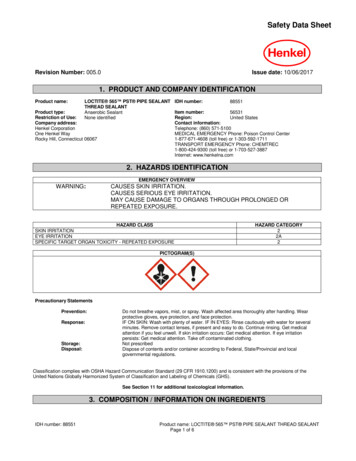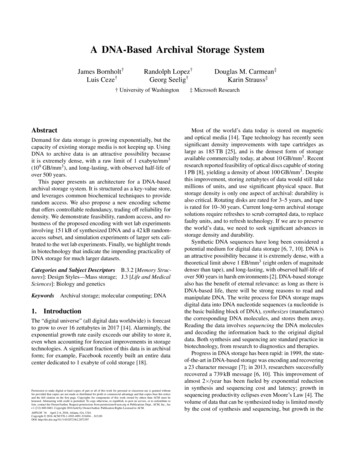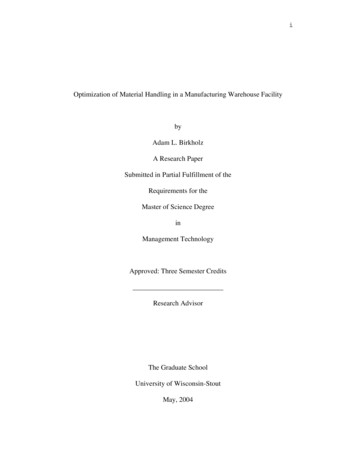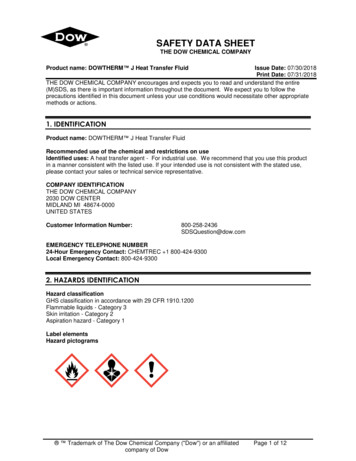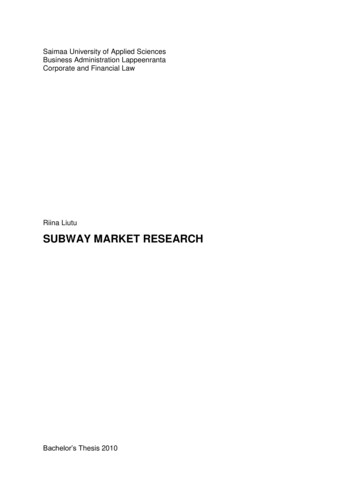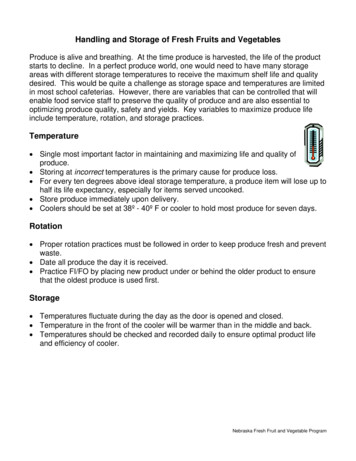
Transcription
Handling and Storage of Fresh Fruits and VegetablesProduce is alive and breathing. At the time produce is harvested, the life of the productstarts to decline. In a perfect produce world, one would need to have many storageareas with different storage temperatures to receive the maximum shelf life and qualitydesired. This would be quite a challenge as storage space and temperatures are limitedin most school cafeterias. However, there are variables that can be controlled that willenable food service staff to preserve the quality of produce and are also essential tooptimizing produce quality, safety and yields. Key variables to maximize produce lifeinclude temperature, rotation, and storage practices.Temperature Single most important factor in maintaining and maximizing life and quality ofproduce. Storing at incorrect temperatures is the primary cause for produce loss. For every ten degrees above ideal storage temperature, a produce item will lose up tohalf its life expectancy, especially for items served uncooked. Store produce immediately upon delivery. Coolers should be set at 38º - 40º F or cooler to hold most produce for seven days.Rotation Proper rotation practices must be followed in order to keep produce fresh and preventwaste. Date all produce the day it is received. Practice FI/FO by placing new product under or behind the older product to ensurethat the oldest produce is used first.Storage Temperatures fluctuate during the day as the door is opened and closed. Temperature in the front of the cooler will be warmer than in the middle and back. Temperatures should be checked and recorded daily to ensure optimal product lifeand efficiency of cooler.Nebraska Fresh Fruit and Vegetable Program
Fresh Fruit and Vegetable Ripening GuideRipening GuideSome fresh fruits continue to ripen after they have been harvested while others do not.Whether or not a fruit continues to ripen is a key factor in determining its storage andshelf life. Fruits that require additional ripening should be stored at room temperatureuntil they become ripe. Fruits that do not ripen after harvesting should be stored in acool area until they are used.Fruits that ripen after insPlumsTomatoesFruits that don’t ripen after onsEthylene Gas: Benefits and effects of harmful exposureFruit can be ripened quickly by introducing ethylene gas into a controlled environment.For example, it is often used to ripen bananas, tomatoes, and avocadoes. Certain fruitscan be placed in a closed bag and the fruit’s natural ethylene can speed the softeningprocess.While ethylene is great for ripening some fruits, the gas can cause premature decay ofother fruits and vegetables that are sensitive to it. To avoid deterioration or rapidripening of sensitive commodities, avoid holding them in the same storage room orrefrigerator compartment with products that emit a great deal of ethylene gas. Diseasedor injured fruits generate substantially increased levels of ethylene, so remove injuredproduce right away. If only one cooler is available, keep lids on storage boxes, storesensitive commodities as far away as possible from ethylene producers, and rotateproduct properly. If produce inventory turns quickly, ethylene should not cause qualityproblemsNebraska Fresh Fruit and Vegetable Program
Fruits that produce largeamounts of wifruit (ripe)MangosPapayasPeachesPearsPlumsFruits/Veggies that are sensitive to ethyleneBananasBeansBroccoliBrussels reensKiwifruit mer SquashSweet PotatoesWatermelonIdeal Storage temperatures for fresh fruits and Vegetables32º to 40º coliBrussels GreensGreen OnionsHerbs (except basil & oregano)Iceberg LettuceKaleKiwifruitAll Leaf LettuceMushroomsNectarinesOnionsOranges (Florida & Texas)Avocados (Ripe)Basil (Fresh)BeansCucumbersEggplantGinger s (California)Oregano (Fresh)ParsleyParsnipsPeachesPears (Fresh-Cut)PeasPineapple outsStrawberriesTurnipsWatercress40º to 50º FPapayaPeppersPineapplesPotatoesSquash (Summer)Tomatoes (Ripe)**Will lose flavor at this temperature during prolonged storageLeave Out of Cold RoomAvocados (Unripe)BananasGrapefruitLimesMangosPears (Unripe)PlantainsPumpkinsShallotsSquash (Winter)Sweet PotatoesTomatoes (Green)Watermelons (Whole)
Storage Hints to Prolong Life of Fresh Fruits and VegetablesTemperature fluctuates from front to back of the cooler due to the location of the cooling unit and frequency of thedoor being opened. Items stored in the front of the cooler have a longer shelf life and can handle the fluctuatingtemperatures. The middle section of the cooler is for items that are less hardly with a more delicate peel or skin.Items in this area including broccoli, green unions and parsley may be sprinkled with crush ice. The slowly meltingice will replace moisture loss and help prevent wilting thus prolonging their shelf life. The back of the cooler is thecoolest area and best suited for the ripest or most perishable items. Sprinkling crushed ice on greens such ascollards, kale and mustard can also help lengthen the life of these products. Consider dividing the cooler into threeareas and store produce as noted sBeetsBroccoliCauliflowerAlfalfa Sprouts*ApricotsBean raOnionsPapayasPearsCherriesCoconutsGrapesGreen OnionsKiwifruitCornFresh-Cut SaladGreensHead arbRipe ressLeaf LettuceParsnipsRipe NectarinesRipe PeachesSpinach*Store as far away from light as possible usually on lower shelfPlease note there are always exceptions to the rules. Tomatoes should not be stored in the cooler. They shouldbe received in a firm state and stored at room temperature to ripen. However, once they have reached maximumripeness, they should be stored in the front of the cooler to slow further ripening until used. In addition, potatoesshould also be stored out of the cooler. Ideally, potatoes – white potatoes and sweet potatoes should be stored at45º - 50º F. Potatoes stored at or below 40º F will convert starches into sugar causing the potato to darken whencooked. Also, protect potatoes from direct light for this will cause them to turn green and cause a bitter taste.Food Service personnel have decisions to make regarding every produce delivery. Practicing good habits such aschecking all produce upon arrival and immediately placing product in the appropriate storage area will helppreserve the quality of the product for when utilized.Nebraska Fresh Fruit and Vegetable Program
Storage Information for Value Added ProduceIf Product Reaches This TemperatureProduct Will StayFresh For:70º F (21º C)4 hours60º F (16º C)1 day50º F (10º C)4 days45º F (7º C)9 days40º F (4º C)14 days35º F (2º C)17 days
Safe Handling Practices for Fresh Producefor FoodserviceJulie A. Albrecht, PhDExtension Food SpecialistUniversity of Nebraska-LincolnPurchasing and ReceivingPurchase food from known safe sources (reputable suppliers) and maintain its safety from timeof receiving through service.When fresh produce is received, follow supplier recommendations, if provided, regardinghandling, storage temperatures, "use by" dates and other recommendations for the produce.Avoid receiving or using damaged and partially decayed produce.Maintain purchasing records of fresh produce.StorageStore raw produce so that it does not contaminate other foods with soil, etc.Store any fresh produce, whole or cut, where other products – especially raw meat and poultry –cannot cross-contaminate it.Segregate fresh produce from other refrigerated foods in refrigeration units by using a separateset of storage racks or separate cooler, if possible.Cover and store washed cut produce above unwashed, uncut fresh produce.Store all produce off the floor. Remember keep all foods 6” off the floor.The Nebraska Food Code requires that melons and tomatoes, that are cut in any way, be heldat 410F or below. To maintain quality of other cut, peeled or prepared fresh fruits andvegetables, refrigerate at 410F or below or hold on a salad bar at 410F or below.Food HandlerWash hands thoroughly with soap and warm running water before and after handling freshproduce.Avoid bare hand contact when preparing and serving fresh produce – use gloves, tongs, delitissue or other appropriate utensils.Nebraska Fresh Fruit and Vegetable Program
Make sure that food employees are reporting illness and are not working while sick.PreparationWash, rinse and sanitize all sinks, utensils, cutting boards, slicers and food preparation surfacesbefore use with fresh produce. If possible, designate specific cutting boards and utensils for usewith fresh produce.Remove outer leaves, stems and hulls from produce like cabbage, head lettuce, berries andtomatoes.Always wash fresh produce under running, potable water before use.Do not use soap or detergent for washing produce as these products are not food grade.Produce washes that are designated for use with produce can be used but are not necessary forproduce safety.Rinse fresh fruits and vegetables under running tap water. Scrub firm fruits and vegetables likepotatoes and carrots with a vegetable brush under running tap water.Soaking produce or storing produce in standing water or ice is not recommended for most typesof fresh produce.Commercial, “fresh-cut” carrots, salad greens and other produce have already been washedbefore processing and should be considered ready-to-eat with no further need for washingunless the label says otherwise.Refrigerate foods prepared with fresh produce ingredients at 410F or below.Label and date all foods prepared with fresh produce ingredients. If not used within 7 days,discard prepared fresh produce.Freshly prepared juice on site requires a HACCP plan.ServiceOn self-serve and salad bars, use small batches of fresh produce and monitor self-service units.Fresh produce should not be held directly on ice.Provide appropriate utensils for self-service of fresh produce.Do not re-serve freshly prepared dishes containing any raw produce, including dishes made withraw tomatoes, cilantro and hot peppers such as salsa and guacamole.Throw away fresh fruits and vegetables that have not been refrigerated (410F or below) within 4hours of cutting, peeling or preparation.
Cutting Vegetables1.JuliennePeel vegetables and trim ends.Slice vegetable into slices.Stack the slices and cut into lengthwise 1/4-inch strips.2.MinceRoughly chop vegetable on cutting board with a large knife.Continue to chop until vegetables are very finely chopped.3.DiceSlice vegetable into slices.Stack slices and slice into 1/4-inch vertical slices.Hold slices tightly with hand and cut crosswise into 1/4-inch intervals4.CubeSlice vegetables into slices.Stack slices and slice into 1/2-inch vertical slices.Hold slices tightly with hand and cut pieces into 1-inch pieces.5.SlicePeel vegetables and trim ends.Slice vegetable on the diagonal at 1/2-inch intervals.Source: default.aspNebraska Fresh Fruit and Vegetable Program
Flavor Intensity of VegetablesThe strength or intensity of the flavor of certain vegetables is due to their sulphur content.Mild FlavoredVegetablesStronger FlavoredVegetablesLeaf Vegetables:SpinachSwiss or red chardBeet greensLettuceCurly kaleMustard greensCabbageBrussels sproutsSeed Vegetables:CornPeasBlack-eyed peasBeansFruit Vegetables:TomatoesEggplantSummer squashWinter squashGreen peppersHot peppersFlower Vegetables:ArtichokesCauliflowerBroccoliStem Vegetables:CeleryAsparagusRoot Crops:CarrotsBeetsSweet potatoesParsnipsTurnipsRutabagasOnionsNebraska Fresh Fruit and Vegetable Program
Garden Salad-to-Go2 cups lettuce4 tomato wedges (use ½ tomato)2 slices cucumber1 radish sliced2 small broccoli florets3-4 carrot sticks1. Place lettuce pieces in a clear plastic-lidded 20-ounce container.2. Place tomato wedge in each of the four corners, diagonal with each corner.3. Place two cucumber slices overlapping in the center of the container.4. Arrange the radish slices on each side of the tomato wedges.5. Place the two broccoli florets on the left and right side of the container.6. Top with carrot sticks.Spinach Salad-to-Go2 cups spinach1 mushroom sliced2 cherry tomatoes1. Place spinach pieces in a large clear plastic lidded container.2. Arrange mushroom slices on the spinach.3. Place a cherry tomato on each side of the container.
Comparison of Ranch DressingsSuggestions for Use of Salad Dressings: Encourage use of non-fat or low-fat dressings.Serve only dressings with 12 grams of fat or less per ounce or per serving. Less is better.Limit the amount served by pre-portioning, using packets, serving dressings to students, settingpumps on ½ oz per squirt, and/or serving salad dressings less often.Per 2 Tbsp ServingCaloriesFat(gm)Sat. otein(gm)0Regular, ocahontas Buttermilk DressingMrs. Clarks Ranch DressingHidden Valley Ranch OriginalMade From Mix104111.3922610.77571523830.5Hidden Valley Ranch from regular mixwith mayonnaiseHidden Valley Ranch from regular mixwith Miracle WhipBottled, Reduced FatHellman’s’ Low fat Ranch DressingMrs. Clark’s Reduced Calorie 5060415231028070Kraft Light Done RightMade From Scratch342.10.7USDA Tool Kit RecipeBottled, Non-Fat3000Wishbone Fat Free RanchNebraska Fresh Fruit and Vegetable Program
Tips to Remember for Your Fruit Salads-To-GoOffering fresh fruits in an attractive and appetizing manner will encourage your customers to choose a nutritiousselection to accompany their main entrée.1. Use colored trays for fruit soufflé cups or a two-inch steam table pan in a refrigerated unit (single layer).2. Do not stack trays; place only one tray at a time.3. Use 4 oz. plastic soufflé cups with lids for canned fruits. Use 4 oz. unlidded plastic soufflé cups for freshfruit.4. Use a colored tray for bananas.5. Keep cut apples or bananas from turning brown by dipping in a cup of lemon or lime juice or pineapplejuice (drained) from canned pineapple.6. For a colorful fruit alternative, place together a half apple and a half orange and serve in a soufflé cup.The orange prevents the apple from discoloring.7. Don’t use metal pans for serving fresh fruit.8. Try serving fresh whole fruits in a wicker basket for an attractive serving alternative.Fruit Salad Bowl-to-Go4-5 1-inch chunks of cantaloupe4-5 1-inch chunks of honeydew4-5 1-inch chunks of watermelon4-5 1-inch chunks of pineapple1 strawberry with stemTip to Remember for Fruit and Vegetable Cups1. Use 4 ounce clear plastic soufflé cups with lids to package individual fruit and vegetable servings.2. When offering more than one serving choice for fruits and vegetables, keep like-colored items separated.Instead, line different colored items next to each other. [Place strawberries next to pears or place carrotsnext to celery.Pre-packed Fruit CupsPack fruit cups with single servings of fresh or canned fruit, or with fruit cup mixtures. Both choices providecustomers with exciting and appetizing options to meet part of the entire ¾ cup fruit/vegetable component.Try offering: Strawberries and blueberries Half a grapefruit with a cherry Strawberries and bananas Peaches and bananas Cantaloupe and watermelons Cherries and bananas Cantaloupe and honeydew Blueberries and pears Apples and orange slices Apples and bananas Apples with blueberries Orange and apple slices Cantaloupe, honeydew and Watermelon Kiwi fruit and grapes Papaya and mangos Grapes and watermelonNebraska Fresh Fruit and Vegetable Program
Pre-packed Vegetable CupsPack vegetable cups with single servings of fresh vegetables or vegetable mixtures. Both choices providecustomers with exciting and appetizing options to meet part or the entire ¾ cup fruit/vegetable component.Try offering Celery and carrot sticks Celery or Carrot sticks with ranch dip Lettuce and tomato mixture Broccoli with ranch dip Broccoli and cauliflower with ranch dipPre-packed Fruit and Vegetable CombinationsPack fruit and vegetable combination cups with fresh fruit and vegetable mixtures. This choice providescustomers with exciting and appetizing options to meet all or part of the ¾ cup fruit/vegetable component.Try offering: Apples with celery sticks Raisins and celery sticks with peanut butter Grapes with carrot sticks Apples with carrot sticks Banana with carrot sticks
Handling and Storage of Fresh Fruits and Vegetables Produce is alive and breathing.
